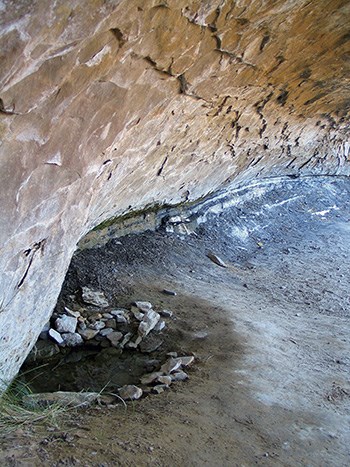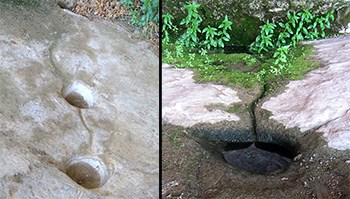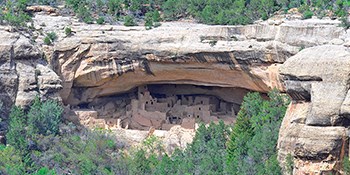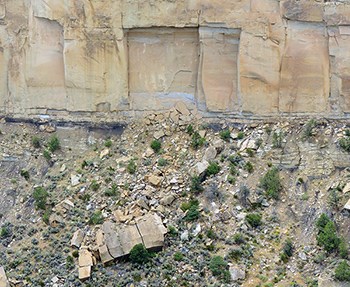
Hydrology of Springs. Where is the Water?
Water is within the rock, particularly the Cliff House Sandstone and Point Lookout Sandstone Formations. As seen in the illustration above, water from rain and snow slowly percolates downward through porous layers of sandstone until the water reaches a non-porous layer of shale, through which the water cannot penetrate. Prevented from moving further down, the water travels sideways along the shale surface. Water can travel for years through the rock until it emerges through a canyon wall. 
The Ancestral Pueblo people likely knew the location of every seep spring on Mesa Verde. They often managed the flow of water emerging from a cliff face by carving small depressions into the shale floor, channeling the water into small pools from which to collect the water. Some, like these, were made just the right size to fit a pottery ladle. 
Alcoves
Alcoves are large, arched recessions formed in a cliff wall. (An alcove is not a cave. Caves are underground chambers, which are not found in Mesa Verde.) The majority of alcoves within Mesa Verde are small crevices or ledges, able to accommodate only a few small rooms. Very few are large enough to house a dwelling the size of Cliff Palace. But alcoves have protected all sizes of cliff dwellings for centuries and largely contribute to their spectacular preservation. 
Alcove formation is assisted by water that is absorbed into and percolates through pores in the Cliff House Sandstone Formation. Beneath and within the sandstone are layers of shale through which moisture cannot penetrate. Water is in constant contact with the sandstone in these areas and dissolves the calcium carbonate that holds the sandstone together. In winter months, when moisture within the rock freezes and expands, chunks of sandstone crack and loosen. Eventually these pieces weaken, collapse, and fall away from the cliff face in blocks. Over time, this process forms alcoves within the cliffs. Pieces of sandstone, created during the formation of alcoves, was often the source of building material for the Ancestral Pueblo homes. |
Last updated: April 21, 2025
